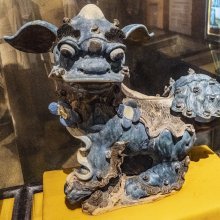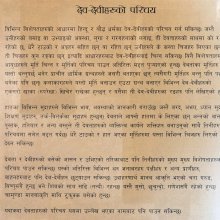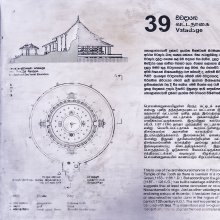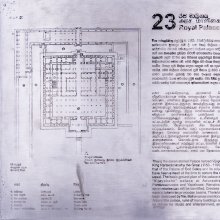Vala, Vāla, Vāḷa, Vaḷa, Vālā, Vāḻa, Vaḷā: 26 definitions
Introduction:
Vala means something in Buddhism, Pali, Hinduism, Sanskrit, the history of ancient India, Marathi, Jainism, Prakrit, Hindi, biology, Tamil. If you want to know the exact meaning, history, etymology or English translation of this term then check out the descriptions on this page. Add your comment or reference to a book if you want to contribute to this summary article.
The Sanskrit terms Vāḷa and Vaḷa and Vaḷā can be transliterated into English as Vala or Valia, using the IAST transliteration scheme (?).
Images (photo gallery)
In Hinduism
Purana and Itihasa (epic history)
Source: archive.org: Puranic EncyclopediaVala (वल).—(bala) An asura. It is stated in Padma Purāṇa, Bhūmikhaṇḍa, how Indra killed this asura.
One day Vala went to the sea for his evening worship. Devendra saw the asura, shining with the radiance of celibacy and the divine rod and deer-hide, praying on the sea-shore. Instantly Indra cut him into two with his weapon, the thunderbolt. Vala fell down motionless. Mention is made about this asura in Ṛgveda, Maṇḍala 1, Anuvāka 4. (For further details see under Bala).
Source: Cologne Digital Sanskrit Dictionaries: The Purana IndexVālā (वाला).—A river from the Vindhyas.*
- * Brahmāṇḍa-purāṇa II. 16. 33.

The Purana (पुराण, purāṇas) refers to Sanskrit literature preserving ancient India’s vast cultural history, including historical legends, religious ceremonies, various arts and sciences. The eighteen mahapuranas total over 400,000 shlokas (metrical couplets) and date to at least several centuries BCE.
Vyakarana (Sanskrit grammar)
Source: Wikisource: A dictionary of Sanskrit grammarVala (वल).—(l) tad. caturarthika affix वलच् (valac) applied to the word शिखा (śikhā) in the four senses country and others; e.g. शिखावलं नगरं देशो वा (śikhāvalaṃ nagaraṃ deśo vā) Kas.on P.IV.2.89; (2) tad. affix वल (vala) in the sense of possession applied to words रजस्, कृषि (rajas, kṛṣi) and others as also to दन्त (danta) and शिखा (śikhā) when the word is used as a proper noun (संज्ञा (saṃjñā)) and to the word ऊर्जस् (ūrjas); e.g. रजस्वला, कृषीवलः, ऊर्जखलः (rajasvalā, kṛṣīvalaḥ, ūrjakhalaḥ) etc.; cl. रजःकृष्यासुतिपरिषदो वलच्, दन्तशिखात्संज्ञायाम् (rajaḥkṛṣyāsutipariṣado valac, dantaśikhātsaṃjñāyām) and ज्योत्स्ना (jyotsnā) ... ऊर्जस्वल (ūrjasvala) ..मलीमसाः (malīmasāḥ) P. V. 2.112, 113, 114.

Vyakarana (व्याकरण, vyākaraṇa) refers to Sanskrit grammar and represents one of the six additional sciences (vedanga) to be studied along with the Vedas. Vyakarana concerns itself with the rules of Sanskrit grammar and linguistic analysis in order to establish the correct context of words and sentences.
Ayurveda (science of life)
Kalpa (Formulas, Drug prescriptions and other Medicinal preparations)
Source: Shodhganga: Edition translation and critical study of yogasarasamgrahaVāḻa [in the Malayalam language] is another name for “Rambhā” and is dealt with in the 15th-century Yogasārasaṅgraha (Yogasara-saṅgraha) by Vāsudeva: an unpublished Keralite work representing an Ayurvedic compendium of medicinal recipes. The Yogasārasaṃgraha [mentioning vāḻa] deals with entire recipes in the route of administration, and thus deals with the knowledge of pharmacy (bhaiṣajya-kalpanā) which is a branch of pharmacology (dravyaguṇa).
Unclassified Ayurveda definitions
Source: Ancient Science of Life: Vaidyavallabha: An Authoritative Work on Ayurveda TherapeuticsVāla (वाल) is a Sanskrit technical term referring to a “child”, and is dealt with in the 17th-century Vaidyavallabha written by Hastiruci.—The Vaidyavallabha is a work which deals with the treatment and useful for all 8 branches of Ayurveda. The text Vaidyavallabha (mentioning vāla) has been designed based on the need of the period of the author, availability of drugs during that time, disease manifesting in that era, socio-economical-cultural-familial-spiritual-aspects of that period Vaidyavallabha.

Āyurveda (आयुर्वेद, ayurveda) is a branch of Indian science dealing with medicine, herbalism, taxology, anatomy, surgery, alchemy and related topics. Traditional practice of Āyurveda in ancient India dates back to at least the first millenium BC. Literature is commonly written in Sanskrit using various poetic metres.
In Buddhism
Theravada (major branch of Buddhism)
Source: Pali Kanon: Pali Proper NamesA horse belonging to King Kappina. DhA.ii.117.
Theravāda is a major branch of Buddhism having the the Pali canon (tipitaka) as their canonical literature, which includes the vinaya-pitaka (monastic rules), the sutta-pitaka (Buddhist sermons) and the abhidhamma-pitaka (philosophy and psychology).
Mahayana (major branch of Buddhism)
Source: academia.edu: A Study and Translation of the GaganagañjaparipṛcchāVāla (वाल) refers to the “hair”, according to the Gaganagañjaparipṛcchā: the eighth chapter of the Mahāsaṃnipāta (a collection of Mahāyāna Buddhist Sūtras).—Accordingly, as the Lord said: “As a small amount of water in the great ocean can be lifted up by means of the tip of a hair (vāla-agra-koṭi), so few beings will have faith in the magical displays of these good men. However, there will be great many beings who do not have faith, compared to the quantity of water in the ocean”.

Mahayana (महायान, mahāyāna) is a major branch of Buddhism focusing on the path of a Bodhisattva (spiritual aspirants/ enlightened beings). Extant literature is vast and primarely composed in the Sanskrit language. There are many sūtras of which some of the earliest are the various Prajñāpāramitā sūtras.
Tibetan Buddhism (Vajrayana or tantric Buddhism)
Source: OSU Press: Cakrasamvara SamadhiVala (वल) refers to a “cavern”, according to the Cakrasaṃvara Samādhi [i.e., Cakrasamvara Meditation] ritual often performed in combination with the Cakrasaṃvara Samādhi, which refers to the primary pūjā and sādhanā practice of Newah Mahāyāna-Vajrayāna Buddhists in Nepal.—Accordingly, “Having joy, passion, and various other emotions, dancing in half paryaṅka, A seal sealed six times! Clothing fallen away, and half of sixteen caverns (ṣoḍaśārdhā-vala-aṅgī)!”.

Tibetan Buddhism includes schools such as Nyingma, Kadampa, Kagyu and Gelug. Their primary canon of literature is divided in two broad categories: The Kangyur, which consists of Buddha’s words, and the Tengyur, which includes commentaries from various sources. Esotericism and tantra techniques (vajrayāna) are collected indepently.
India history and geography
Source: Cologne Digital Sanskrit Dictionaries: Indian Epigraphical GlossaryVāla.—(IE 8-5; EI 15; CII 3), cf. sa-bhūta-vāta-pratyāya, etc.; probably, storms (cf. udvāta; also called āvāta.) Note: vāla is defined in the “Indian epigraphical glossary” as it can be found on ancient inscriptions commonly written in Sanskrit, Prakrit or Dravidian languages.

The history of India traces the identification of countries, villages, towns and other regions of India, as well as mythology, zoology, royal dynasties, rulers, tribes, local festivities and traditions and regional languages. Ancient India enjoyed religious freedom and encourages the path of Dharma, a concept common to Buddhism, Hinduism, and Jainism.
Biology (plants and animals)
Source: Wisdom Library: Local Names of Plants and DrugsVala in the Marathi language is the name of a plant identified with Chrysopogon zizanioides (L.) Roberty from the Poaceae (Grass) family having the following synonyms: Vetiveria zizanioides, Vetiveria odorata. For the possible medicinal usage of vala, you can check this page for potential sources and references, although be aware that any some or none of the side-effects may not be mentioned here, wether they be harmful or beneficial to health.
Source: Google Books: CRC World Dictionary (Regional names)1) Vala in India is the name of a plant defined with Pavonia odorata in various botanical sources. This page contains potential references in Ayurveda, modern medicine, and other folk traditions or local practices It has the synonym Hibiscus oligosandrus Buch-Ham. (among others).
2) Vala is also identified with Vetiveria zizanioides It has the synonym Pseudoraphis squarrosa (L.f.) Chase (etc.).
Example references for further research on medicinal uses or toxicity (see latin names for full list):
· Monographiae Phanerogamarum (1889)
· Contributions from the United States National Herbarium (1917)
· Annals of the Missouri Botanical Garden (1994)
· Systema Vegetabilium (1817)
· Journal of Cytology and Genetics (1983)
· Supplementum Plantarum (1781)
If you are looking for specific details regarding Vala, for example diet and recipes, pregnancy safety, extract dosage, chemical composition, health benefits, side effects, have a look at these references.

This sections includes definitions from the five kingdoms of living things: Animals, Plants, Fungi, Protists and Monera. It will include both the official binomial nomenclature (scientific names usually in Latin) as well as regional spellings and variants.
Languages of India and abroad
Pali-English dictionary
Source: BuddhaSasana: Concise Pali-English Dictionaryvāla : (m.) hair of the tail. (adj.), fierce; malicious.
Source: Sutta: The Pali Text Society's Pali-English Dictionary1) Vāḷa, 2 (misspelt for vāda?) music (?) Pgdp 83. (Page 610)
2) Vāḷa, 1 (cp. late Sk. vyāḍa, see Geiger, P. Gr. § 546) 1. a snake Vism. 312 (so read for vaḷa).—2. a beast of prey A. III, 102 (amanussa); J. I, 295; III, 345 (°macchā predaceous fishes); Miln. 23 (°vana forest of wild beasts).
— or —
1) Vāla, 3 (nt.) (=vāri, cp. late Sk. vāla) water; only in cpd. °ja a fish (cp. vārija). (Page 610)
2) Vāla, 2 (adj.) (cp. Sk. vyāla) malicious, troublesome, difficult Vin. II, 299 (adhikaraṇa). (Page 610)
3) Vāla, 1 (Vedic vāla; connected with Lat. adūlāre (ad+ ūlāre) to flatter (lit. wag the tail, like a dog), cp. E. adulation; Lith. valaī horse hair) 1. the hair of the tail, horse-hair, tail Vin. II, 195=J. V, 335 (pahaṭṭha-kaṇṇavāla with bristling ears & tail, of an elephant); J. V, 274 (so read for phāla, cp. p. 268, V, 113); PvA. 285 (°koṭi, so read for bāla°); Sdhp. 139.—pallaṅkassa vāle bhinditvā destroying the hair (-stuffing) of a couch Vin. II, 170=DA. I, 88; cp. Vin. IV, 299: pallaṅko āharimehi vālehi kato.—On v. in similes see J. P. T. S. 1907, 136.—2. a hair-sieve (also Vedic) M. I, 229.
— or —
Vaḷa, at Vism. 312 is to be read vāḷa (snake), in phrase vāḷehi upadduta “molested by snakes. ” (Page 603)

Pali is the language of the Tipiṭaka, which is the sacred canon of Theravāda Buddhism and contains much of the Buddha’s speech. Closeley related to Sanskrit, both languages are used interchangeably between religions.
Marathi-English dictionary
Source: DDSA: The Molesworth Marathi and English Dictionaryvala (वल).—See under ओ.
--- OR ---
valā (वला).—and compounds See under ōlā. Some few, as not obvious, or as having some new sense or application (peculiarly perhaps amongst Deshpeople, and thus pertaining to this form of spelling) appear in order here.
--- OR ---
vaḷa (वळ).—m A tumor arising in the groin, the axillæ, or behind the ear; a bubo &c. 2 Twist or convolution (of a rope &c.) 3 m f The mark made by a lash or stroke, a weal. 4 Cramp in the limbs. 5 m Impatient eagerness; uneasy longing; itching.
--- OR ---
vaḷa (वळ).—f (āvali S) A line, row, rank. 2 A line as drawn by the pen, or a line of writing. 3 fig. Course, fashion, line of deportment or procedure.
--- OR ---
vāla (वाल).—m (valla S) A weight consisting of three guñja (seed of Abrus precatorius). Popularly it is computed at two or two and a half guñja. Pr. aṭatāṃ vāla piṭatāṃ vāla vāla vāla nisantāna A vāla in melting, a vāla in hammering, here a vāla, there a vāla,--and the gold is gone. Expressive of the rapacious roguery of the goldsmith, and, hence, of any imperceptible expenditure or consumption unto absolute exhaustion. 2 A pulse, a small variety of pāvaṭā, Dolichos spicatus. 3 The seed of the tree cilhārī.
--- OR ---
vālā (वाला).—decl affix (lā-lī-lēṃ m f n. H) Used in comp. with nouns and verbs in the sense of Doer, maker, vender, professor, possessor, correspondingly with man, monger &c. in Coach-man, milk-man, cheese-monger; and with er in Speak- er, writer, walker. Ex. bōlaṇēvālā, dēṇēvālā, bandūka- vālā, dārūvālā, paikēvālā, ābrūvālā. Such compounds are endless, and are, of course, excluded.
--- OR ---
vālā (वाला).—a & ad (Vulgar, for vēgaḷā) Separate &c. See vāyalā.
--- OR ---
vālā (वाला).—m A large and thick rope. 2 W A narrow and short cloth for the middle of the body; commonly called pañcā.
--- OR ---
vāḷa (वाळ).—f C A pot-herb, Basella rubra vel alba.
--- OR ---
vāḷa (वाळ).—a Ceased to be current or become depreciated--a coin. 2 Ejected from caste. 3 fig. Fallen out of employment, use, or observance--an article, an ordinance, a practice.
--- OR ---
vāḷa (वाळ).—f Cessation or depreciation of currency (of coins). v pāḍa & paḍa with acc. of s. 2 Ejection from caste and society, i. e. ejected state. v kāḍha g. of o., v nigha g. of s., v pāḍa, ghāla, paḍa acc. of o. 3 (vāḷaṇēṃ To dry.) Decayedness, dried up and wasted state, witheredness. v paḍa, hō, asa g. of s. 4 Obsoleteness, desuetude, disused state. v paḍa, hō g. of s. vāḷīnta ghālaṇēṃ To eject from caste and society. vaḷīnta paḍaṇēṃ To fall into this outcast state.
--- OR ---
vāḷā (वाळा).—m (valluka S) A grass of which the roots are fragrant and are used for tatties &c., Andropogon muricatum. Applied also to the roots. Otherwise known as khasakhasa.
--- OR ---
vāḷā (वाळा).—m (vālaka S) A sort of bracelet or anklet. Pr. nāṃva sōnubāī hātānta kathalācā vāḷā. 2 A ring or loop (as of a fetter &c.): an annular ridge around certain vessels: also a circular and flat bottom or stand (as of a wine glass or pyālā): also a ring, or round, or circlet generally. 3 A creature of the serpent-tribe: also a young snake generally. 4 Cocoanut-parings (as the residue after making vādyā, such being annular). 5 A brand on the body with the bracelet of this name. 6 A tumor esp. in the groin, a bubo.
Source: DDSA: The Aryabhusan school dictionary, Marathi-Englishvaḷa (वळ).—m A tumour arising in the groin, Twist. m f Cramp in the limbs. f A line; course.
--- OR ---
vāla (वाल).—m A weight consisting of 3 guñja A pulse.
--- OR ---
vāḷa (वाळ).—f Cessation of currency. Ejected state. vāḷīnta ghālaṇēṃ Eject from caste and society.
--- OR ---
vāḷā (वाळा).—m A fragrant grass. An anklet.
Marathi is an Indo-European language having over 70 million native speakers people in (predominantly) Maharashtra India. Marathi, like many other Indo-Aryan languages, evolved from early forms of Prakrit, which itself is a subset of Sanskrit, one of the most ancient languages of the world.
Sanskrit dictionary
Source: DDSA: The practical Sanskrit-English dictionaryVala (वल).—See बल (bala).
--- OR ---
Vāla (वाल).—See, बार्ह, बार्हद्रथ, बार्हद्रथि, बार्हस्पत, बार्हस्पत्य, बार्हिण, बाल, बालक (bārha, bārhadratha, bārhadrathi, bārhaspata, bārhaspatya, bārhiṇa, bāla, bālaka).
See also (synonyms): vārha, vārhadratha, vārhadrathi, vārhaspata, vārhasatypa, vārhiṇa, vālaka.
Source: Cologne Digital Sanskrit Dictionaries: Edgerton Buddhist Hybrid Sanskrit DictionaryVala (वल).—[, so Lefm with most mss., and Calcutta (see LV.) bala, in Lalitavistara 429.22 (prose)-nagnavalānupradāna-, which certainly must mean giving clothes to the naked. Neither bala nor vala nor even vara is recorded in any such meaning as garment or cloth. Two mss. are reported as reading vaila, which obviously intends caila; so read with Foucaux (Notes 206).]
Source: Cologne Digital Sanskrit Dictionaries: Shabda-Sagara Sanskrit-English DictionaryVala (वल).—n.
(-laṃ) An army, forces. E. val to surround, aff. kaḥ see bala .
Source: Cologne Digital Sanskrit Dictionaries: Cappeller Sanskrit-English DictionaryVala (वल).—[masculine] cave, cavern; [Name] of a demon (cf. 2 bala).
--- OR ---
Vāla (वाल).—[masculine] tail-hair, horse-hair, tail, bristle; hair-sieve.
Source: Cologne Digital Sanskrit Dictionaries: Monier-Williams Sanskrit-English Dictionary1) Vala (वल):—[from val] 1. vala m. ‘enclosure’, a cave, cavern, [Ṛg-veda; Atharva-veda; Brāhmaṇa]
2) [v.s. ...] a cloud, [Naighaṇṭuka, commented on by Yāska i, 10]
3) [v.s. ...] a beam or pole, [Kātyāyana-śrauta-sūtra [Scholiast or Commentator]]
4) [v.s. ...] Name of a demon (brother of Vṛtra, and conquered by Indra; in later language called bala q.v.)
5) [from val] 2. vala = vali (See śata-vala).
6) Vāla (वाल):—1. vāla m. (later form of 1. vāra; also written bāla q.v.) the hair of any animal’s tail ([especially] of a horse’s tail), any tail or hair, [Taittirīya-saṃhitā] etc. etc.
7) bristle, [Kathāsaritsāgara]
8) a hair-sieve, [Vājasaneyi-saṃhitā; Śatapatha-brāhmaṇa]
9) mn. a kind of Andropogon, [Varāha-mihira’s Bṛhat-saṃhitā; Suśruta]
10) Vālā (वाला):—[from vāla] f. the cocoa-nut, [cf. Lexicographers, esp. such as amarasiṃha, halāyudha, hemacandra, etc.]
11) [v.s. ...] a kind of jasmine, [cf. Lexicographers, esp. such as amarasiṃha, halāyudha, hemacandra, etc.]
12) [v.s. ...] Pavonia Odorata, [cf. Lexicographers, esp. such as amarasiṃha, halāyudha, hemacandra, etc.]
13) [v.s. ...] = śiphā, [cf. Lexicographers, esp. such as amarasiṃha, halāyudha, hemacandra, etc.]
14) [v.s. ...] Name of a Yoginī, [Hemādri’s Caturvarga-cintāmaṇi]
15) Vāla (वाल):—2. vāla n. (said to be) = parvan, [Nirukta, by Yāska xi, 31.]
Source: Cologne Digital Sanskrit Dictionaries: Yates Sanskrit-English Dictionary1) Vala (वल):—(ṅa) valate 1. d. To cover; move; surround. (ka) vālayati 10. c. To cherish, maintain.
2) (laṃ) 1. n. An army.
Source: DDSA: Paia-sadda-mahannavo; a comprehensive Prakrit Hindi dictionary (S)Vala (वल) in the Sanskrit language is related to the Prakrit words: Vala, Vāla, Vālā.
[Sanskrit to German]
Sanskrit, also spelled संस्कृतम् (saṃskṛtam), is an ancient language of India commonly seen as the grandmother of the Indo-European language family (even English!). Closely allied with Prakrit and Pali, Sanskrit is more exhaustive in both grammar and terms and has the most extensive collection of literature in the world, greatly surpassing its sister-languages Greek and Latin.
Hindi dictionary
Source: DDSA: A practical Hindi-English dictionaryVālā (वाला):——a suffix denoting an agent, doer, owner, possessor, keeper or inhabitant; hence [vālī] feminine form.
...
Prakrit-English dictionary
Source: DDSA: Paia-sadda-mahannavo; a comprehensive Prakrit Hindi dictionary1) Vala (वल) in the Prakrit language is related to the Sanskrit word: Val.
2) Vala (वल) also relates to the Sanskrit word: Āropa.
3) Vala (वल) also relates to the Sanskrit word: Grah.
4) Vala (वल) also relates to the Sanskrit word: Vala.
5) Vāla (वाल) also relates to the Sanskrit word: Vāla.
6) Vāla (वाल) also relates to the Sanskrit word: Vyāla.
7) Vāla (वाल) also relates to the Sanskrit word: Vāla.
8) Vālā (वाला) also relates to the Sanskrit word: Vālā.
Prakrit is an ancient language closely associated with both Pali and Sanskrit. Jain literature is often composed in this language or sub-dialects, such as the Agamas and their commentaries which are written in Ardhamagadhi and Maharashtri Prakrit. The earliest extant texts can be dated to as early as the 4th century BCE although core portions might be older.
Kannada-English dictionary
Source: Alar: Kannada-English corpusVala (ವಲ):—
1) [noun] the plant Dolichos lablab ( = Lablab niger) of Papilionaceae family.
2) [noun] its pod; flat bean.
--- OR ---
Vāla (ವಾಲ):—
1) [noun] hair.
2) [noun] the flexible appendage to the trunk of some animals; a tail.
3) [noun] the fragrant root of cus-cus grass (Vetiveria zizanioides =andropogon muricatus).
4) [noun] the grass Hordeum vulgare of Poaceae family.
5) [noun] a sharp-pointed organ in scorpion, used to prick, wound or inject poison.
--- OR ---
Vāḷa (ವಾಳ):—[noun] a mass of new tissue growth independent of its surrounding structures, having no physiological function (which may either be benign or malignant); neoplasm.
--- OR ---
Vāḷa (ವಾಳ):—
1) [noun] hair.
2) [noun] the flexible appendage to the trunk of some animals; a tail.
3) [noun] the fragrant root of cus-cus grass (Vetiveria zizanioides =andropogon muricatus).
4) [noun] the grass Hordeum vulgare of Poaceae family.
5) [noun] a sharp-pointed organ in scorpion, used to prick, wound or inject poison.
Kannada is a Dravidian language (as opposed to the Indo-European language family) mainly spoken in the southwestern region of India.
See also (Relevant definitions)
Starts with (+508): Balakridanaka, Val-ariuri, Val-attikuruvi, Vala-kal-vattuatanam, Vala-manjadi, Vala-ottunal, Vala-valaenal, Vala-vayvanku, Vala-yashti, Valaa, Valaa, Valaa, Valabamukha, Valabandha, Valabandhana, Valabbe, Valabha, Valabhamukha, Valabhapattana, Valabhapattanam.
Ends with (+1084): Achitavala, Adapavala, Adavala, Adaviparivala, Adhivala, Adigevala, Adivala, Aduvala, Agaravala, Agavala, Aggavala, Aghivala, Agivala, Agnijvala, Agravala, Ahivala, Ahvala, Ajavala, Ajravala, Akevala.
Full-text (+504): Valam, Valavilaiyattu, Valabhid, Valapparicam, Valavay, Aravada, Valappatu, Valakkattayam, Valavottam, Valanatu, Kanavala, Satavala, Valamati, Nahanavali, Prishadvala, Hemavala, Nadvala, Shikhavala, Manivala, Durvala.
Relevant text
Search found 67 books and stories containing Vala, Vāla, Vāḷa, Vaḷa, Vālā, Vāḻa, Vaḷā, Valā, Vāḷā; (plurals include: Valas, Vālas, Vāḷas, Vaḷas, Vālās, Vāḻas, Vaḷās, Valās, Vāḷās). You can also click to the full overview containing English textual excerpts. Below are direct links for the most relevant articles:
Rig Veda (translation and commentary) (by H. H. Wilson)
Yogadrstisamuccaya of Haribhadra Suri (Study) (by Riddhi J. Shah)
Chapter 3.4b - Prātibhajñāna –The intuitive knowledge < [Chapter 3 - Introduction to the Yogadṛṣṭisamuccaya]
Chapter 6.4 - Adhyātmasāra by Upādhyāya Yaśovijaya < [Chapter 6 - Influence of the Yogadṛṣṭisamuccaya]
Chapter 4.1e - Yogabīja (Seeds of Yoga) < [Chapter 4 - The Eight Yogadṛṣṭis and the nature of a Liberated Soul]
The Garuda Purana (by Manmatha Nath Dutt)
Chapter CXCVII - Preparations of medicinal oils and Ghritas < [Dhanvantari Samhita]
Chapter CCXXVII - Different names of the Ayurvedic Drugs < [Dhanvantari Samhita]
Chapter LXVIII - Description of the origin of gems in the treatise on Ratna Pariksa (test of gems) < [Agastya Samhita]
Women in the Atharva-veda Samhita (by Pranab Jyoti Kalita)
21. Goddessess Sinīvālī, Kuhū, Anumati and Rākā < [Chapter 4 - Female Deities and the Glorification of Women in the Atharvaveda]
Impact of Vedic Culture on Society (by Kaushik Acharya)
Chart: Movement of Vedic Brāhmaṇas < [Chapter 3]
Select Sanskrit Inscriptions Found in Northern India < [Chapter 1]
Mingling of Cultures (C): The Maitrakas < [Chapter 4]
Garga Samhita (English) (by Danavir Goswami)
Verses 5.19.6-7 < [Chapter 19 - The Festival on Śrī Kṛṣṇa Return]
Related products







